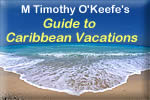St.
Croix Christiansted Afoot Part 2 |
Government House is classic Danish architecture. | ||||
|
6. Government House: Located on King Street beyond The Steeple Building, it is considered one of the finest examples of Danish architecture remaining in the islands. It was built in 1747 as a home for a wealthy Danish merchant. The Danish government purchased the house in 1771 and connected it to a house on the corner of Queen Cross Street. It became the seat of Danish government. The building still houses government offices and a court. Its most striking feature is the elegant 18th century staircase rising from the street into the building. 7. Lutheran Church: Built in the 1740s as the Dutch Reformed Church, it became the Lutheran Church in 1834. 8. Apothecary Hall: On Company Street, this was an 18th-century pharmacy and a private residence. It has been carved up into offices, a restaurant and boutiques. 9. The Market Place: Another half-block beyond Apothecary Hall on Company Street . It is not nearly as colorful or as interesting as the markets on some other islands. Since 1735, this has been the place to buy fresh, locally-grown vegetables and fruits. 10. King Street/King's Alley: A prime waterfront shopping area housed in what were once old trading houses. This section features boutiques and open-air restaurants; an enjoyable place to window shop. 11. Protestant Cay: The small island-hotel at the harbor entrance is typically called the Hotel on the Cay. Its original name comes from the era of French ownership, when only Catholics could be buried on the big island. Protestants were buried on this tiny spit of land. When the French left St. Croix around 1696, pirates turned it into a favorite meeting point. |
|||||
